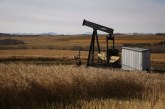
There’s a lot of discussion about the future of oil, so let’s talk about it.
Globally, we consume 96 million barrels of oil everyday. This is the same as 48 super tankers of
oil, every 24 hours.
So what is all that oil used for? Well, we as consumers, we use almost all of it.
If you take a barrel of oil, 42% of it will be turned into gasoline, for our commuter vehicles. 28%
will be turned into diesel, which runs our commercial fleet, including trucks, trains and barges
used in transporting goods. 12% is split between fuel oil and aviation fuel, for heating and travel,
respectively, and the last 18% is used for asphalt, petrochemicals and plastics.
Oil has no substitute. Renewable energy, nuclear, coal – none of them can create gasoline, jet
fuel or asphalt that runs our communities.
Understanding the future of oil demand ultimately means understanding the future of population.
Let us explain.
Canada is apart of a group called the Organization for Economic Co-operation and Development
or the “OECD” made up of Canada, the US, most countries in Europe and a handful of others
which are what we often refer to as ‘developed’ nations. The OECD has 1.3 of the 7.2 billion people on earth,
and we are by far the biggest energy users. However, our population is stable and we are becoming more
efficient with our energy use.
The developing world is a little different. While China has settled out at about 1.4 billion people,
or 5 times the population of America, the rest of the developing world is still growing. India,
who already has 1.3 billion people, is estimated to add another 300 million more by 2040. The
rest of the world, including Latin America, the Middle East, Asia and Africa, already have 2.9
billion people, will add a further billion and a half in the same period. This means that in the
developing world, it is likely that an additional 1.7 billion people will be added totally 7.3 billion
in the developing world alone.
In developing nations, people are moving into big cities, gaining access to electricity and buying
their first cars. Each person in the developing world is estimated to increase their energy use by
60% by 2040 as they move towards a standard of living the developed world has enjoyed for
decades.
Of the 96 million barrels of oil produced today, it’s split about half and half between developed
and developing nations.
A quarter century from now, in 2040, as OECD countries become more efficient with energy
use, oil demand is projected to go down from about 46 down to 38 million barrels per day. That’s
a reduction of about 8 million barrels of oil per day. In contrast, developing nations, who
currently use 41 million barrels per day, are projected to use 26 million more by 2040, totaling
67 million barrels per day as a result of increased urbanization.
Combined, this means over the next 25 years, despite a wide adoption of the electric car in
wealthy countries and increased energy efficiency around the world, the global demand for oil
will likely go up by another 18 million barrels per day until about 2040 where it is expected to
level out and start to decline. In other words, growth in population and increased urbanization
will outpace the electric car and energy efficiency for oil consumption. These are projections
from the International Energy Agency, the gold standard of energy models.
The biggest unknown for the future of oil is the rise of the electric car. There’s a wide range in
opinions of the speed that our society will adopt this transformational technology. Some believe
that in as little as 15 years, the majority of our cars will be electric, displacing much of our oil
use. Others are more skeptical at how quickly the entire global vehicle fleet will be able to make
this transition. While it might be unsettling for many, oil consumption will increase for years to
come.
While public efforts to reduce our dependency on oil often target oil producers or pipelines, its
important to understand that oil consumption is driven by consumer demand. History has show
over and over that targeting the producer of high demand products has little to no effect on
curbing consumption. Instead, capacity for change lies within us, the end user, in changing our
consumption behavior to move towards to a low emission future.
Share This:
You can read more of the news on source



